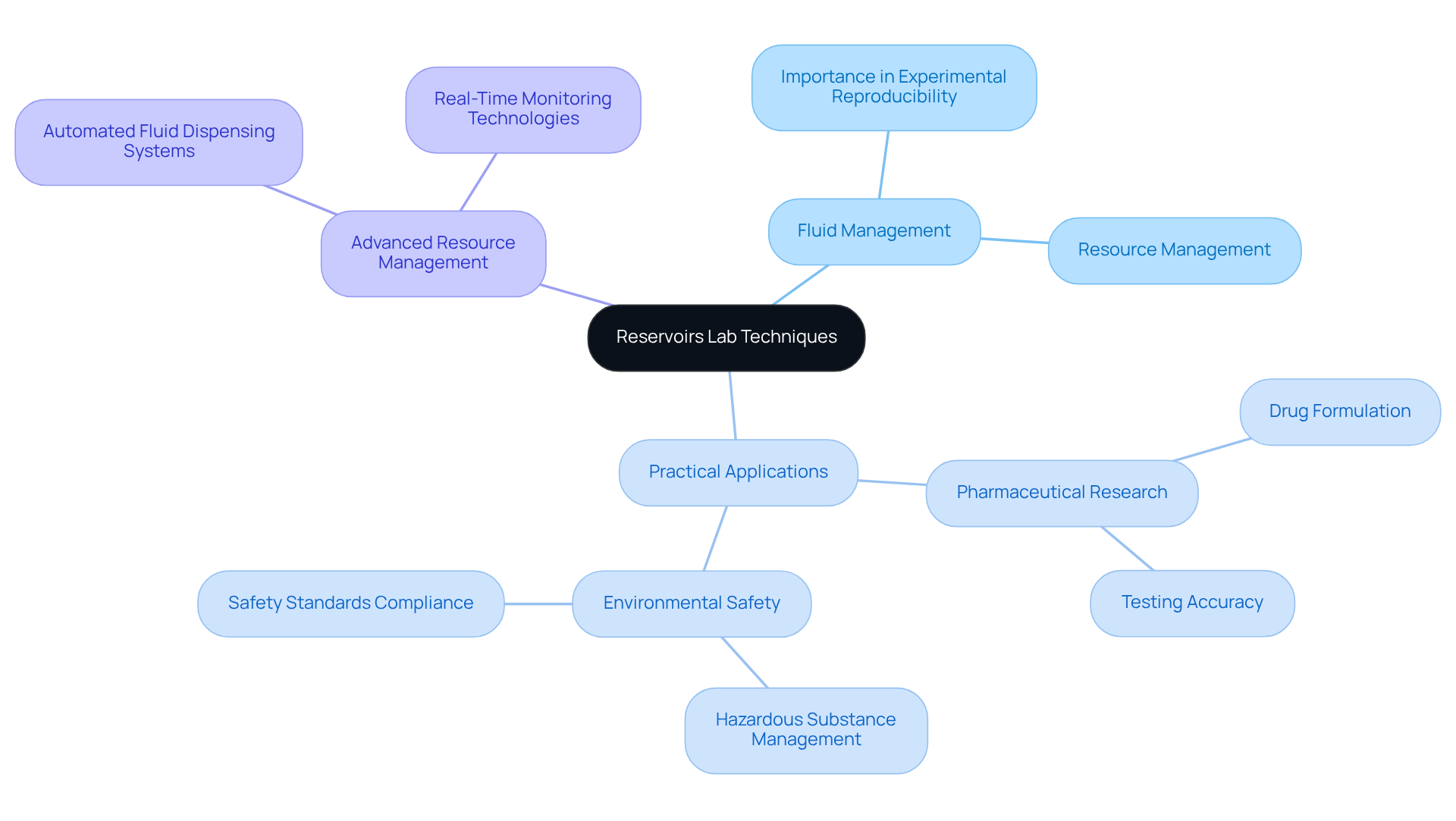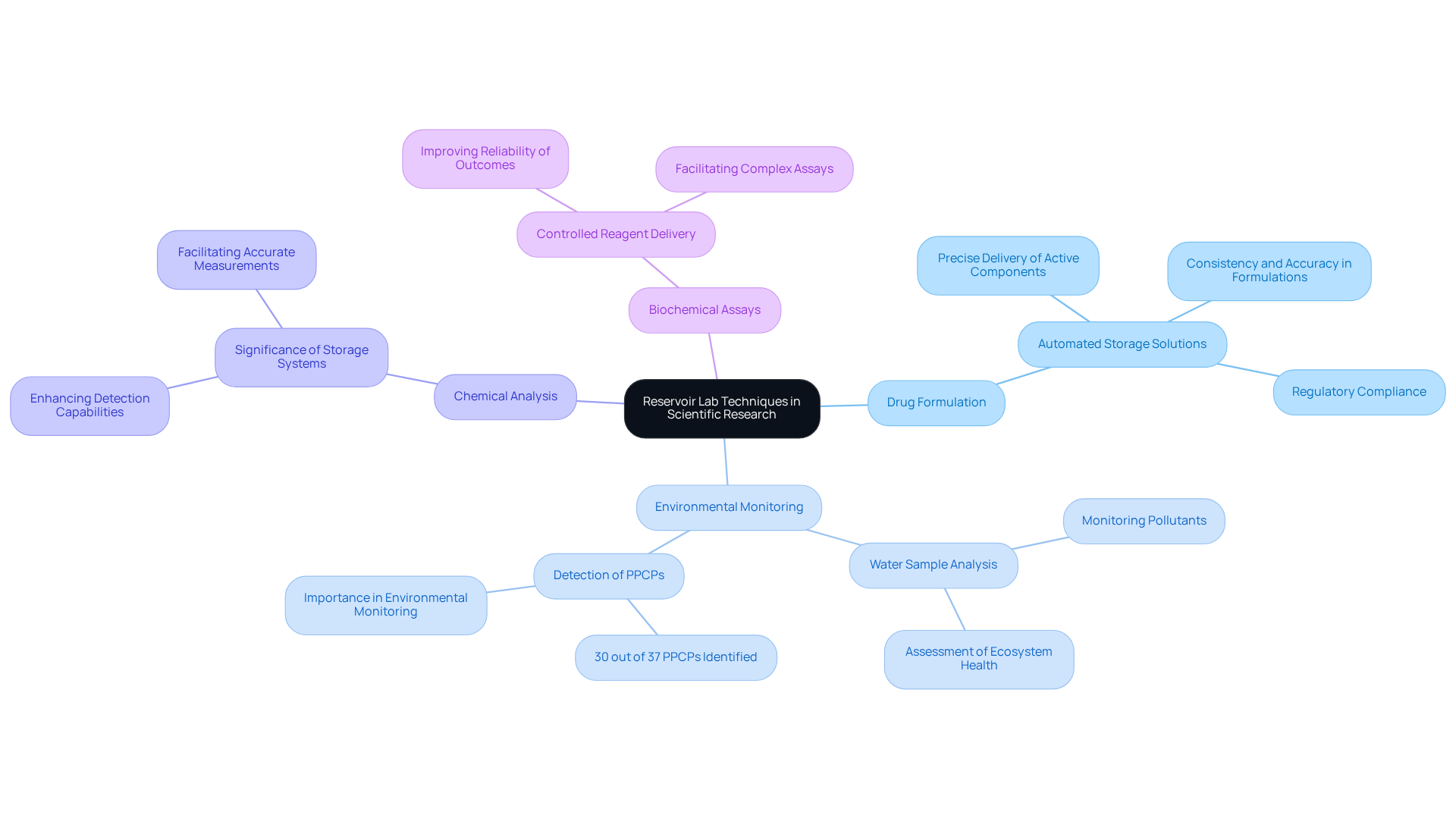Overview
This article provides a comprehensive overview of reservoirs lab techniques, focusing on their definition, historical context, key characteristics, and practical applications in scientific research. It underscores the critical importance of precision, control, and adaptability in these techniques, which are vital for effective fluid management across diverse scientific disciplines. Such qualities ensure that experimental outcomes are both accurate and reliable, thereby reinforcing the necessity of high-quality scientific instruments in laboratory settings.
Introduction
The intricate world of reservoir lab techniques is pivotal in scientific research, where precise control over the management of various substances is essential. These methodologies not only enhance the accuracy and reliability of experiments but also adapt to the evolving needs of diverse scientific fields, from pharmaceuticals to environmental monitoring.
As the complexity of these systems grows, so does the challenge of ensuring effective resource management and minimizing human error. Innovations and historical advancements have significantly shaped the current landscape of reservoir lab techniques, continuing to influence scientific exploration today.
Define Reservoirs Lab Techniques
Techniques in the reservoirs lab encompass a range of methodologies designed to effectively manage and utilize reservoirs of fluids, gases, or other materials within laboratory environments. These techniques are essential across various scientific disciplines, including chemistry, biology, and environmental science, especially in reservoirs lab, where precise control over the storage and delivery of substances is paramount. Reservoirs lab can take the form of physical containers or sophisticated systems engineered to hold and dispense materials in a controlled manner, thereby ensuring that experiments and analyses are executed with accuracy and reliability.
The importance of fluid management in reservoirs lab settings cannot be overstated. Effective resource management contributes to enhanced experimental reproducibility and reliability, which are critical for scientific validation. Research has demonstrated that inadequate fluid management in reservoirs lab can result in considerable discrepancies in experimental results, highlighting the necessity for strong storage methods.
Practical applications of these methodologies are evident in various environments, including reservoirs lab. For instance, in pharmaceutical research within reservoirs lab, precise fluid management is crucial for drug formulation and testing, where even minor discrepancies can significantly affect therapeutic efficacy. Furthermore, reservoirs lab and environmental facilities employ robust storage methods to handle hazardous substances securely, ensuring adherence to safety standards while preserving the accuracy of their analyses.
Expert insights emphasize the importance of implementing advanced resource management methods in the reservoirs lab to enhance workflow efficiency. By adopting innovative solutions, such as automated fluid dispensing systems and real-time monitoring technologies, facilities can significantly improve efficiency and minimize the risk of contamination or errors. As the research community continues to evolve, the role of efficient resource management in the reservoirs lab will remain a fundamental aspect of successful experimental practices.

Explore the Historical Context of Reservoirs Lab Techniques
The evolution of storage systems within experimental environments can be traced back to early research trials, where the need for controlled conditions became apparent. Initially, basic containers were employed for the storage of reagents and samples. However, as scientific inquiry advanced, so did the complexity of these systems. A pivotal development occurred in the late 20th century with the advent of automated dispensing devices, revolutionizing workflows by enabling enhanced accuracy and efficiency in liquid management. This innovation not only streamlined processes but also mitigated human error, representing a significant milestone in scientific history.
Recent data indicates that the word error rate (WER) for spoken-digit recognition utilizing electronic computing has reached an impressive 0.014%, showcasing the potential of advanced technologies to enhance efficiency in research settings. Moreover, ongoing advancements in materials science and engineering have facilitated the creation of sophisticated storage systems capable of maintaining specific conditions, such as temperature and pressure.
As noted by Charles Kuen Kao, 'Optical fiber communication is frequently seen as one of the most important technological innovations of the 20th century,' underscoring the importance of progress in research environments. These developments have greatly expanded the functionality of water storage systems in the reservoirs lab for research and diagnostics, leading to more accurate and reliable experimental results. The continuous evolution of fluid handling techniques in research facilities underscores the vital role of reservoirs lab in fostering scientific exploration.
Additionally, case studies examining the application of storage computing in data centers reveal the practical implications and advancements in storage frameworks, further emphasizing their significance in modern laboratories.

Identify Key Characteristics and Components of Reservoirs Lab Techniques
The key characteristics of storage lab techniques are precision, control, and adaptability. These setups typically incorporate various storage units such as tanks, vials, and syringes, alongside dispensing devices like pumps and valves, and monitoring equipment including sensors and data loggers.
- Precision is achieved through calibrated instruments that ensure accurate measurements and deliveries. The FDD Direct Drive pump exemplifies this capability, achieving resolutions as fine as a single microliter and demonstrating stability metrics of up to 98%.
- Control is maintained through automated mechanisms that can adjust parameters in real-time, ensuring consistent performance even during extended operations, where a steady flow rate is essential for preserving data quality.
- Adaptability is critical; different experiments may necessitate specific setups or materials, requiring flexible structures in the reservoirs lab that can meet diverse scientific needs.
For instance, the introduction of a continuous flow setup has eliminated pulsation, thereby enhancing the accuracy of liquid transfer in microreactor applications. This improvement significantly boosts data quality and reduces the adjustment time needed for measurements.
As noted by Fluid Metering, Inc., their equipment is engineered for greater efficiency, cost-effectiveness, and reliability, which directly conserves resources in laboratory environments.
Examine Practical Applications and Examples in Scientific Research
Techniques from the reservoirs lab are essential in a diverse range of scientific research applications, particularly in drug formulation, chemical analysis, and environmental monitoring.
- Automated storage solutions, for example, are increasingly employed in pharmaceutical research to deliver precise quantities of active components during drug development. This practice ensures consistency and accuracy in formulations, which are vital for regulatory compliance and product efficacy.
- In the realm of environmental science, storage systems are indispensable for collecting and analyzing water samples, enabling researchers to effectively monitor pollutants and assess ecosystem health.
- Recent studies have shown that water storage systems can significantly enhance the detection of pharmaceutical and personal care products (PPCPs) in water. Findings indicate that 30 out of 37 PPCPs were identified in raw water samples, highlighting the importance of these systems in environmental monitoring.
- Additionally, in biochemical laboratories, containers facilitate the controlled delivery of reagents during complex assays, thereby improving the reliability of experimental outcomes.
These applications underscore the critical role that reservoirs lab techniques play in advancing scientific knowledge and innovation, particularly in addressing contemporary environmental challenges and enhancing public health outcomes.

Conclusion
The significance of reservoirs lab techniques in scientific research is paramount, providing essential frameworks for the precise and controlled management of various substances. These methodologies are integral to ensuring that experiments yield reliable and reproducible results, which are critical for scientific validation across multiple disciplines, including pharmaceuticals and environmental science.
Key insights discussed throughout the article include:
- The evolution of storage systems
- The importance of effective fluid management
- The advanced technologies that enhance laboratory efficiency
The historical context underscores how innovations, such as automated dispensing devices, have revolutionized workflows. Furthermore, the characteristics of reservoirs lab techniques—precision, control, and adaptability—illustrate their vital role in addressing the diverse needs of contemporary scientific inquiry.
In light of these discussions, it is clear that continued investment in and development of reservoirs lab techniques are essential for advancing scientific knowledge and tackling pressing global challenges. Researchers and facilities are urged to adopt innovative solutions and best practices in fluid management to improve their experimental accuracy and efficiency. This commitment ultimately contributes to the betterment of public health and environmental sustainability.




